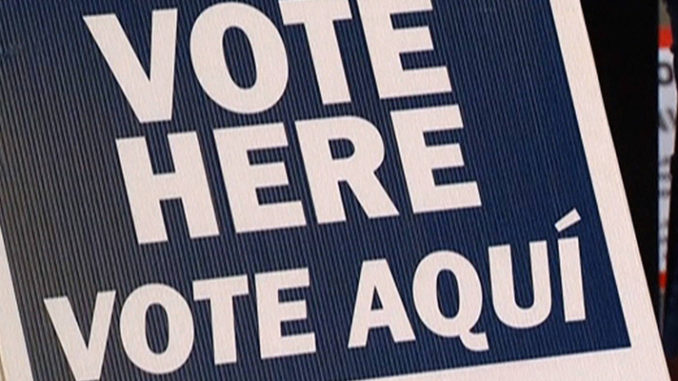
by Alfredo Corchado
The immigration news is grim: a plan for looming massive family roundups for deportations, a report of children detained in America without enough food and water, and a nation embroiled in debate over whether or not to welcome asylum seekers with open arms.
Ruth Gilmer knows what to do. She moved here from her native Mexico decades years ago. She’s angry, but also inspired.
To vote.
“This is not about being Mexican,” said Gilmer, a U.S. citizen for 30 years who is among the millions of Latinos in the U.S. who are growing more determined than ever to have their voices heard during the primary and presidential votes next year.
“This is about being humanitarian, caring about your fellow human being,” said Gilmer, 54, “But as a Mexican what’s happening along the border and against immigrants in this country, this hurts twice as much. The only defense you have is your vote.”
Across the country, Hispanics like Gilmer, a tax accountant born in Sahuayo in the Mexican state of Michoacan, are increasingly motivated and energized to vote, especially in hotly contested states like Michigan where she lives. Donald Trump won Michigan’s 16 electoral votes by about 10,700 votes in the last presidential election.
For Democrats to have a chance at recapturing the White House, they’ll need to dominate the Latino vote, especially in crucial states like Michigan and the Lone Star State where two Texans are vying for the Democratic nomination.
Trump’s crackdown on unauthorized immigration – popular among his base – is expected to fuel a historic turnout among Latinos who may vote to try and protect their more vulnerable family and friends. Latinos are on pace to become the largest nonwhite voting bloc as more than 32 million Latino voters will be eligible to cast ballots in the 2020 presidential election, surpassing African Americans for the first time.
“Latinos can make the difference in battleground states like Michigan, Wisconsin, Pennsylvania, Arizona, Georgia, Nevada and, of course, Texas – that’s where we will see the biggest impact,” said Lydia Camarillo, president of the Southwest Voter Education Project.
“It could be in this cycle that Texas turns purple. Voters have a lot of choices in candidates, more than 20, but they have two of their own,” she said, referring to former Housing Secretary Julian Castro and former U.S Rep. Beto O’Rourke. “It’s a win-win for Texas.”
Putting Texas in play
Both Texans — Castro from San Antonio and O’Rourke from El Paso — are part of the lineups for the first Democratic presidential debates, set for Wednesday and Thursday in Miami.
O’Rourke’s political star has dimmed a bit for now, but his political muscle in Texas is well entrenched. In one poll he leads all Democratic candidates, including front-runner Joe Biden, who edges him out in other polls. And his unsuccessful run against Republican incumbent Ted Cruz for the U.S. Senate is credited for mobilizing hundreds of thousands of new voters, particularly younger ones, including Latinos. In the Senate race, Latinos backed O’Rourke over Cruz by nearly 2-to-1, according to the Pew Research Center.
This week, O’Rourke’s campaign immediately pounced on Trump’s deportation message, which the president, with a tweet, delayed Saturday for at least two weeks to give Democrats and Republicans a chance to broker a deal.
Earlier in the week, O’Rourke’s campaign reminded supporters to contribute, saying “Beto is from El Paso, a city of immigrants, refugees and asylum seekers. A city whose story reflects the story of our nation. He knows the contributions immigrant communities have made to this country, and he has a unique message to contrast with Donald Trump on this key moral issue.”
Political strategist Jorge Urby, founder of The Glider Group in San Antonio, has worked for O’Rourke and is now advising Castro. Both candidates, he said, will be crucial to mobilizing more Latinos in Texas and across the country to the ballot box.
“Julian will have more connection with Latinos because he is Latino, but he’s not well known yet,” he said, adding that Castro and O’Rourke, if they’re viable candidates when the primaries start next February, can compete for states like Texas, California and Nevada with a possible edge for Castro among Hispanic voters. “Beto, give him credit. He really energized voters, especially younger ones, and that’s key. He’s from the border and he speaks Spanish, but at the end of the day [not being Latino] he can only understand the border and Latinos in a certain way. They grew up so differently, too.”
Yet, Urby added, for Democrats the 2020 election will be more about “who can beat Trump and push back against his policies. Not about who the candidate is. Whoever can do that, win,” will get the backing of Hispanic voters, he added.
“But if the nominee is a Texan, watch out,” he said, then added, “That’s a giant ‘if.’ Democrats have a lot of work to do in Texas before we can safely call this a purple state. But there is a new energy.’”
Awakening Latino vote
Long considered bears in hibernation, the big political awakening for Latinos, especially younger ones, came during last year’s midterm elections, according to Pew.
Hispanic registered voter turnout (and the Asian turnout) increased to about 40% in last year’s midterm elections. That’s a 13% increase over 2014, when turnout rates had declined to record lows. But turnout is key, according to Alex Gonzalez of the Latino Public Policy Foundation. In 2016, about 27 million Hispanics were eligible to vote, but only 11.5 million voted.
Meanwhile, voter turnout rates for whites, at 57.5%, and blacks, at 51.4%, increased by 11.7 and 10.8 percentage points, respectively, since 2014, according to Pew.
Romancing Hispanic voter promises a bigger payback as the first debates get under way thanks to Trump, experts say. His policies remind them of election results in California back in the 1990s and in Arizona last year when Democrats picked up a Senate seat. Anti-immigrant measures in both states galvanized entire communities to become new Democratic voters.
To be sure, unlike African American voters who tend to vote in overwhelming numbers for Democrats, Hispanics are far from being monolithic, experts like Camarillo and others are quick to note. In fact, some 28% supported Trump during the 2016 election.
Moreover, Trump’s economy has led to more jobs for more Americans, including Latinos, leading to more employment.
Latinos also tend to be more conservative, and many Latino immigrants originate in countries where they’re running away from dictators, or left-leaning governments. The Trump campaign, for instance, is reaching out to Cuban Americans, Venezuelans and Nicaraguans. Vice President Mike Pence is scheduled to announce the Trump campaign’s plan to reach out to Hispanics on Tuesday in Miami. Many Latinos also consider themselves anti-abortion, making some weary of the Democratic contenders who favor abortion rights and bigger government, Urby said.
Some Latinos favor Trump’s call for a wall on the Mexican border to discourage undocumented migration.
But experts say the conservative loyalty of many Latinos shouldn’t be taken for granted when Trump’s anti-immigrant message targets relatives or neighbors of Latino voters. In fact, Trump’s rhetoric appears to be driving up hostility among Hispanics, making it harder for other Republican candidates to secure their support.
“Scapegoating Latinos is a bad strategy,” Camarillo said. “This has led to an impressive growth among Latino voters,” despite, she added, a lack of “investment on the part of political parties, wealthy donors, including unions,” she said, noting that Democrats need to do more to capitalize on Hispanic support, especially in battleground states. Biden, for example, has received pushback by Latinos for not doing enough to court them.
Others experts agree.
“The 2018 midterm election was a referendum on Trump, and the very clear message of Hispanic voters, who overwhelmingly supported Democratic candidates for Congress, was that they disapprove of the current administration,” added Melissa Michelson, professor of political science at Menlo College.
“Given his track record of rhetoric and policies, I don’t think there’s much chance that Hispanic support for Trump will improve by next November, so we might see strong Hispanic turnout in favor of whoever ends up getting the Democratic nomination,” she said. “We’re going to see higher than usual turnout among Hispanic voters next year, regardless of who gets the nomination.”
In the 2020 election, according to Pew, Hispanics will be the largest minority group in the electorate, accounting for more than 13% of eligible voters, surpassing African Americans.
Mary Luevanos, 78, has lived in her southwest neighborhood in Detroit, otherwise known as Mexicantown, for much of her life. Talk of a history of deportations runs deep in her state, all the way back to when Mexicans worked at the Ford Motor Co. for $5 a day. The jobs were so attractive that Mexicans came by the hundreds, if not thousands, from central Mexico and parts of Texas. Many Hispanics also ended up doing agriculture work, including picking cherries in Traverse City, a tradition that continues today.
But over the generations, deportations have also pushed family, friends and neighbors back to Mexico, past and current signs of a fickle country. Even so, Luevanos is hopeful, she says, because of dozens of young people who walk around her neighborhood registering Hispanics to vote, hoping to turn them into a powerful political bloc capable of defending themselves against politicians who they say are simply using them for political theater.
“That’s where my hope lies, in the young people,” said Luevanos, a visual art storyteller. “I tell them, vote like your life is depended on that, and these days it is. We should all walk around with pads to register people to vote.”
Alfredo Corchado is Border-Mexico correspondent for the Dallas Morning News and author of Homelands: Four Friends, Two Countries, and the Fate of the Great Mexican-American Migration.



